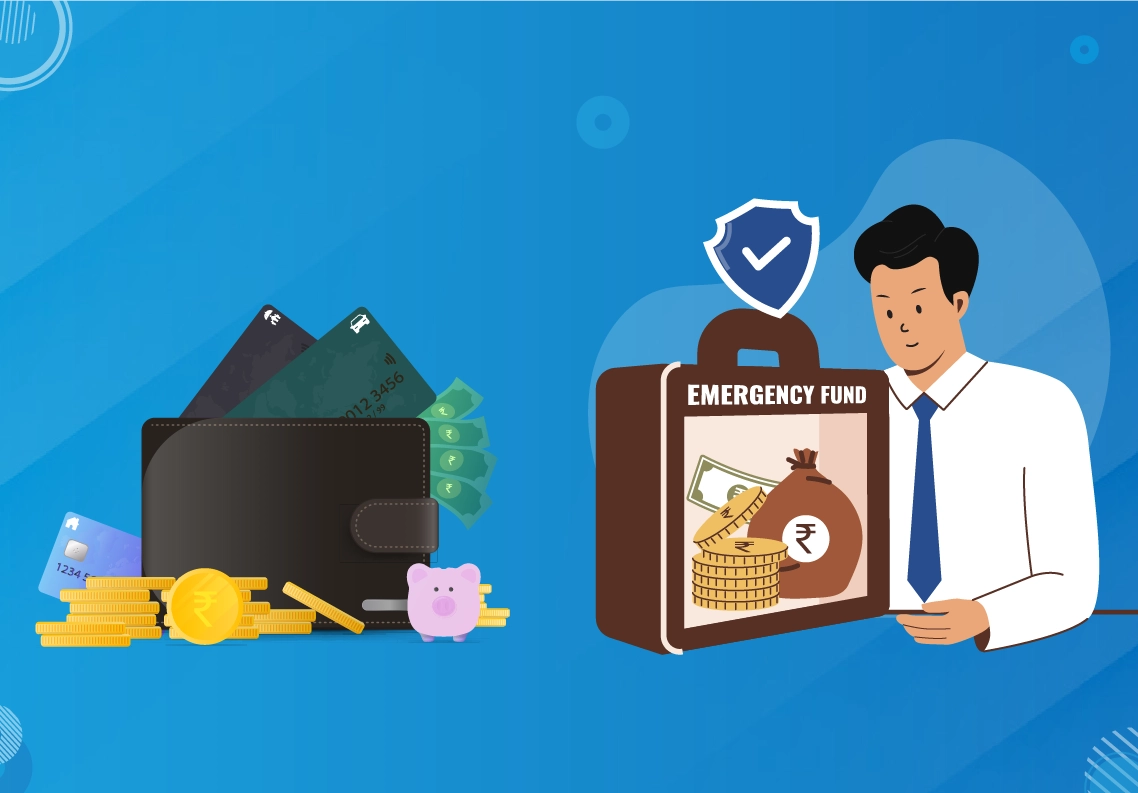- Blog

In the current economic scenario, marked by rising geopolitical tensions and fluctuating market conditions, financial stability has become more important than ever.
Creating an emergency fund can provide a vital safety net during such unpredictable periods. But how do you effectively build one without straining your budget? Here’s a practical guide to help you set up and maintain an emergency fund.
Why You Need an Emergency Fund
An emergency fund is a distinct savings account reserved solely for unforeseen expenses. It acts as a financial cushion during events like sudden job loss, medical emergencies, or urgent home repairs. Here’s why having one is essential:
-
Financial Security:
Without a financial buffer, you might have to always rely on loans or credit cards to cover unexpected expenses, leading to high-interest debt. An emergency fund mitigates this risk by providing immediate access to cash.
-
Peace of Mind:
Knowing you have money set aside for emergencies can significantly reduce financial stress. It allows you to focus on resolving the crisis rather than worrying about how to pay for it.
-
Protection from Lifestyle Disruption:
With a financial cushion, you can maintain your standard of living even when unexpected expenses arise.
How Much Should Your Emergency Fund Be?
The general recommendation is to save three to six months’ worth of essential living expenses. To calculate your target amount:
- Step 1: List your monthly expenses, including rent, utilities, groceries, transportation, and loan repayments.
- Step 2: Multiply the total by three to six months to determine your savings goal.
For instance, if your essential monthly expenses total ₹50,000, your emergency fund should ideally range from ₹1.5 lakh to ₹3 lakh. However, the exact amount may vary depending on your job stability, dependents, and existing financial obligations.
Strategies for Building an Emergency Fund:
-
Break It Down into Smaller Goals
Starting with a large savings target can feel overwhelming. Instead, divide it into manageable segments. Begin by saving one month’s worth of expenses. Once achieved, aim for the next month’s target. Gradually increase your savings goal until you reach your desired amount. So, if your goal is to save ₹1.44 lakh in 12 months, breaking it down to ₹12,000 per month will make the target more achievable and keep you motivated.
-
Start with Small, Regular Contributions
You don’t need to save a huge amount right away. Instead, set aside a small, fixed amount each month. This approach helps you get into the habit of saving without straining your cash flow. Identify areas where you can cut back, like reducing dining-out expenses or limiting online shopping, and then redirect the savings into your emergency fund account. If you decide to save ₹1,000 every week, you will accumulate ₹52,000 in a year – a substantial start toward your emergency fund.
-
Automate Your Savings
One of the easiest ways to build an emergency fund is to automate your savings. Set up a separate savings account reserved specifical;ly for your emergency fund and arrange for automatic transfers from your primary account every payday. Automating the process ensures consistency, reducing the temptation to spend the money elsewhere. For this, consider using a recurring deposit or a savings account that gives higher interest rates to grow your fund faster.
-
Avoid Lifestyle Creep
Once you’ve automated your savings, resist the urge to increase discretionary spending. Often, people start saving but then inadvertently increase their expenses, nullifying their efforts. Monitor your spending habits regularly to identify unnecessary expenses. If you still have disposable income after saving, consider increasing your contribution amount instead of spending it.
-
Explore Additional Income Streams
Supplementing your income can accelerate the fund-building process. Consider part-time work, freelancing, or monetizing hobbies to generate extra cash specifically for your emergency fund. Online tutoring, content writing, or consulting can provide flexible, income-generating opportunities. Deposit all earnings from side gigs directly into your emergency fund to boost its growth. Over time, even small amounts can accumulate into a significant safety net.
-
Direct Windfalls and Bonuses to Your Fund
Unexpected income, such as tax refunds, work bonuses, or cash gifts, can provide a substantial boost to your emergency savings. Instead of spending it, allocate a portion, or all of it, to your emergency fund. So, say you receive a ₹10,000 bonus, consider saving ₹7,000 and using the remaining ₹3,000 for discretionary spending. This way, you can make significant progress toward your goal without affecting your regular budget.
-
Avoid Over-Saving
While building an emergency fund is crucial, there’s no need to overdo it. Once you’ve reached your target, consider redirecting your savings toward higher-yield investments. Emergency funds should remain liquid and accessible, which often means lower interest rates. Any surplus beyond your target can be invested in fixed deposits, mutual funds, or retirement accounts for better returns. This way, you maximize your financial growth without keeping too much idle cash in a low-interest account.
How to Keep a Check on Your Emergency Fund
Building an emergency fund isn’t a one-time task. It requires regular monitoring and adjustments. For that:
-
Reassess Your Goal Periodically:
As your financial situation evolves, such as a salary increase, marriage, or having children, your emergency fund requirements may change. Recalculate your goal every six months to ensure it aligns with your current lifestyle.
-
Maintain Consistent Contributions:
Even after reaching your target, continue making small contributions. This practice helps you maintain the habit of saving while accounting for inflation or rising living costs.
-
Avoid Dipping Into the Fund Unnecessarily:
The emergency fund is strictly for unforeseen expenses. If you find yourself regularly withdrawing from it for non-emergencies, reconsider your spending habits and make necessary adjustments to your budget.
-
Review Your Account Type:
If your emergency fund is in a low-interest savings account, consider moving it to a high-yield savings account or a fixed deposit to earn better returns while keeping it accessible.
Bottomline:
An emergency fund is not just a financial tool – it’s a source of peace of mind in uncertain times. You can build a strong financial safety net by setting smaller goals, staying consistent, and automating your contributions, all without impacting your daily budget.
If you are in the initial stages of creating the emergency fund, and an urgent requirement arises, consider using financial products like HDB Financial Services’ Personal Loan to handle urgent expenses while keeping your savings intact. This way, you can stay on course to building the fund even in challenging circumstances.
To apply for a personal loan Click here
























































